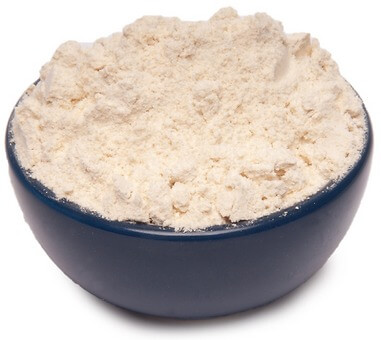Popular Gluten-Free Flours

 Our gluten-free flours make it easy for you to bake and enjoy foods that ditch the gluten. Each of these flours can help you on your way to achieving gluten-free baking perfection. Today we’ll explore the unique attributes of almond flour, coconut flour, gluten-free all purpose baking flour, tapioca flour, and quinoa flour.
Our gluten-free flours make it easy for you to bake and enjoy foods that ditch the gluten. Each of these flours can help you on your way to achieving gluten-free baking perfection. Today we’ll explore the unique attributes of almond flour, coconut flour, gluten-free all purpose baking flour, tapioca flour, and quinoa flour.
Almond Flour
As our top-selling gluten-free flour, blanched almond flour is truly a baking delight. Baked goods made with this low-carb flour are light, moist, and delicious. Perhaps one of almond flour’s best characteristics is that it’s so versatile. Almond flour can be substituted as a one-to-one replacement for wheat flour in most recipes. It’s loaded with the same protective antioxidants and monounsaturated fats as the nuts it’s made from, and also boasts a rich source of protein.
Organic Coconut Flour
Like almond flour, our organic coconut flour is another low-carb, gluten-free baking alternative to wheat flour. Made from dried coconut meat, this flour is delicate and lends a rich texture to baked goods. It absorbs moisture like a sponge so recipes with coconut flour often call for more eggs or other wet ingredients to compensate for this attribute. Typically, coconut flour can be substituted for up to 20% of the wheat flour in a recipe. Coconut flour is a rich source of fiber, which can make it particularly filling.
Gluten-Free All Purpose Baking Flour
Our gluten-free all purpose baking flour is a blend of different gluten-free flours that makes it extremely versatile in breads, pancakes, muffins, cakes, and other recipes. Since gluten helps baked goods hold their shape, our gluten-free all purpose baking flour is specifically designed to compensate for the lack of gluten. It contains garbanzo bean flour, potato starch, tapioca flour, whole grain sweet white sorghum flour, and fava bean flour which work best when they’re used together. As a good source of protein and dietary fiber, this blend is also very nutritious!
Tapioca Flour
Although it is commonly used as a thickener in sauces and gravies, tapioca flour, also known as tapioca starch, can also work its magic in gluten-free baking. Tapioca flour is a smooth, powdery flour made from the roots of the cassava plant. Its starchy quality adds structure to gluten-free baking, which helps compensate for the lack of gluten. When used in combination with other gluten-free flours, tapioca starch can add chewiness to cookies, and a crispness to pizza crusts. Since tapioca flour has a neutral taste, it won’t compete with other flavors in your recipes.
Made solely from ground quinoa, organic quinoa flour is loaded with the same rich nutritional content of the grain-like seed, including a big boost of protein, amino acids, dietary fiber, calcium, and iron. Organic quinoa flour is a delicate ingredient that gives baked goods a slightly nutty flavor and light, fluffy texture. When baking with quinoa flour, substitute it for half of the all-purpose flour in recipes, or all of the wheat flour in baked goods such as cakes and cookies.
What are your favorite gluten-free flours to use for baking?


2 Responses to “Popular Gluten-Free Flours”
What is the ratio of coconut flour, almond flour, etc. to regular flour commonly used in baking ?
Does it follow the same measurements .. one cup of the gluten free, to one cup of regular and so on ??
Hi Mary! Thanks for your question. Almond flour can be substituted as a one-to-one replacement for wheat flour in recipes. Coconut flour can be substituted for up to 20% of the wheat flour in a recipe. However, this can vary by recipe so if you’re just starting out, it’s best to follow recipes that have been developed specifically with gluten-free flours.